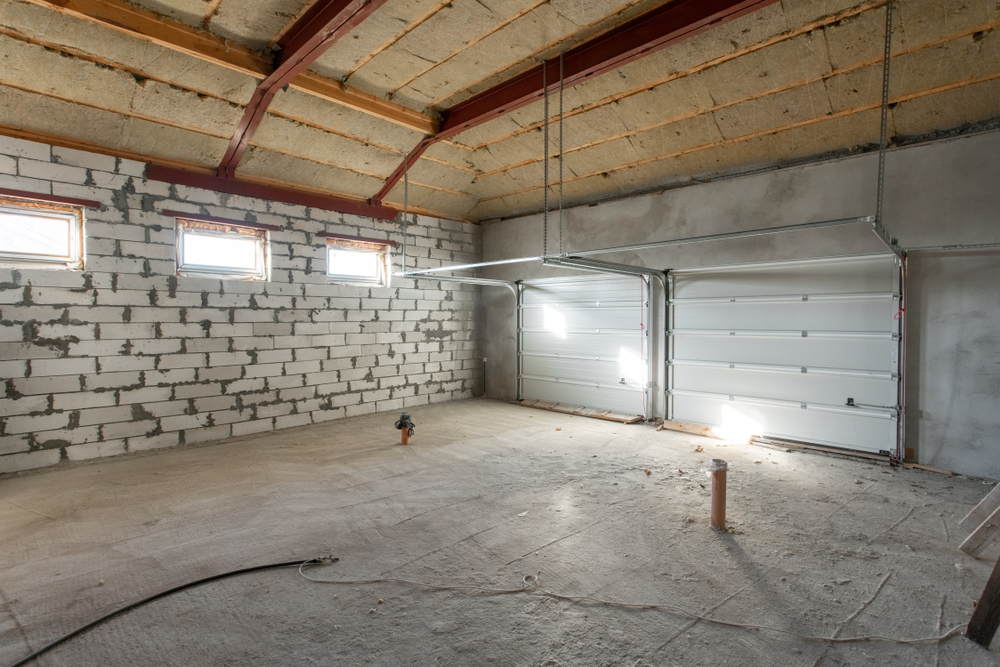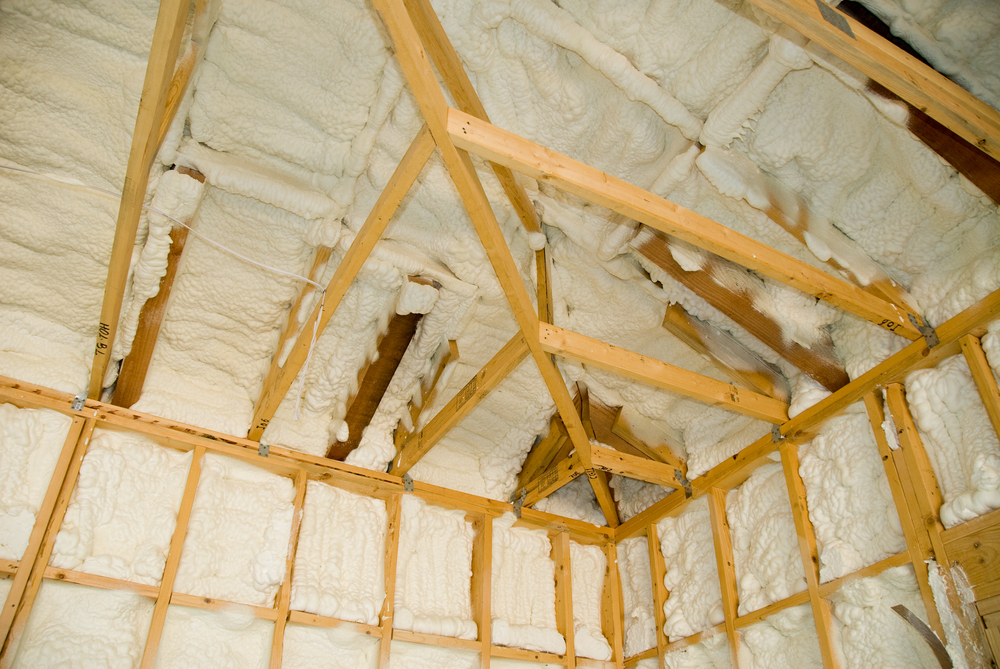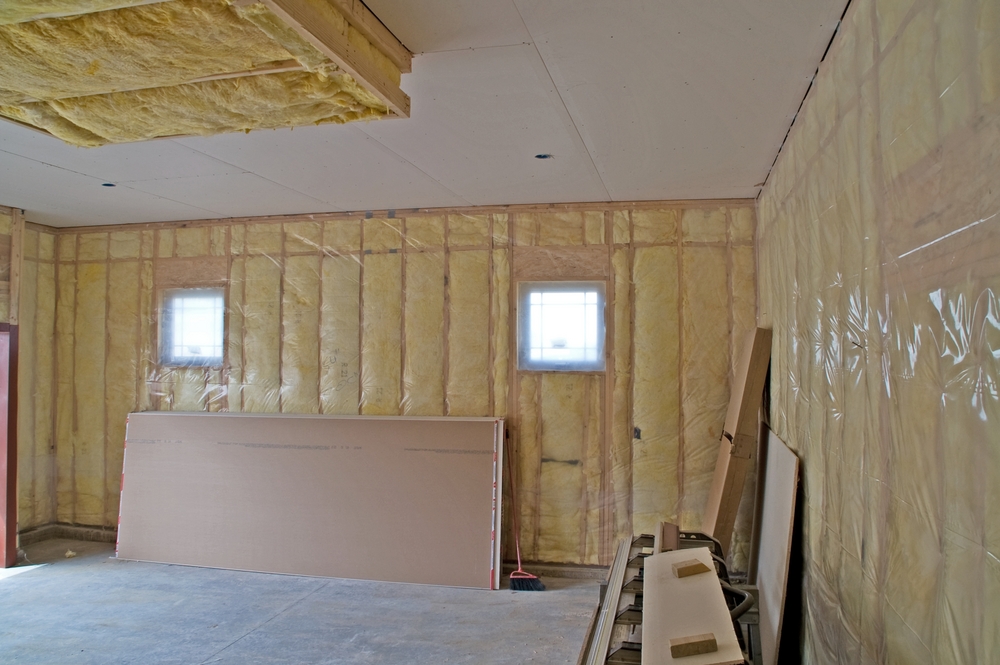March 4, 2024 - Benjamin Ehinger
Garage Ceiling Insulation: Key Benefits and Installation Tips
CALL NOW 844-762-8449
Insulating your garage ceiling is a smart move for managing the temperature and increasing the energy efficiency of your space. Whether you have a room above your garage or you simply want to make your garage more comfortable, ceiling insulation can make a noticeable difference. By addressing this area, you can mitigate heat loss during winter and prevent heat gain during summer, leading to a more consistently pleasant space for your hobbies, storage, or car protection.
While considering garage ceiling insulation, you’ll come across various materials and installation methods, each with its own set of advantages. It’s important to select the right type of insulation that meets the needed R-value—a measure of thermal resistance—for your specific climate and garage setup. Also, proper ventilation and moisture control are essential to prevent mold and ensure the durability of the installation.
During the process of insulating your garage ceiling, be prepared for some waste material. Utilize a small roll-off dumpster rental to handle debris efficiently, so your remodeling project remains clean and organized.
 Proper installation of garage ceiling insulation is essential for achieving maximum energy efficiency and safety in your home. Following the correct steps will ensure a well-insulated garage, capable of maintaining a consistent temperature and reducing noise levels.
Proper installation of garage ceiling insulation is essential for achieving maximum energy efficiency and safety in your home. Following the correct steps will ensure a well-insulated garage, capable of maintaining a consistent temperature and reducing noise levels.
 When insulating your garage ceiling, it’s vital to incorporate effective ventilation and moisture control strategies. Adequate ventilation prevents the buildup of condensation, which can lead to mold growth and wood rot in your garage structure.
Why is Ventilation Important?
When insulating your garage ceiling, it’s vital to incorporate effective ventilation and moisture control strategies. Adequate ventilation prevents the buildup of condensation, which can lead to mold growth and wood rot in your garage structure.
Why is Ventilation Important?
Remember, the upfront cost of insulation can be offset by lower energy bills over time. Ensure that your investment is appropriate for your climate zone and personal needs, as it can vary significantly.
Moreover, consider the longevity of the insulation material. Higher quality materials might come with a higher initial cost but could provide better thermal resistance and, therefore, more long-term savings. Additionally, some local governments offer tax credits or rebates for energy-efficient home improvements, which can help mitigate the overall cost. Always verify these offers in your area before proceeding.
When budgeting, remember to account for both materials and installation unless you plan to install the insulation yourself. The DIY route may save costs but requires a careful assessment of your skills and the time investment needed.
Key Takeaways
- Insulating the garage ceiling improves temperature control and energy efficiency.
- Choose insulation with the appropriate R-value and ensure proper installation.
- Rent a small dumpster to easily dispose of waste during the installation process.
Benefits of Garage Ceiling Insulation
When you insulate your garage ceiling, you are investing in energy efficiency. Insulation acts as a barrier to heat flow, helping to keep your garage warmer in the winter and cooler in the summer. This means less energy is required to heat or cool your space, which can lead to lower utility bills. A well-insulated garage can also enhance the comfort of adjacent living spaces. By stabilizing the temperature in the garage, you make it easier to maintain a comfortable environment in rooms that share a wall with the garage. Furthermore, garage ceiling insulation can contribute to a quieter home. It serves as a sound dampener, reducing the noise that travels into your home from both inside the garage, such as from power tools, and external sources like traffic. Insulation Choices:- Fiberglass Batts: Common and easy to install.
- Rigid Foam: Offers high insulating value per inch.
- Spray Foam: Seals leaks and gaps with an expanding barrier.
- Energy Efficiency: Reduces the need for heating/cooling.
- Cost Savings: Potential reduction in energy bills.
- Comfort: Creates a more stable environment.
- Noise Reduction: Insulation acts as a sound barrier.
Types of Insulation Materials
When selecting insulation for your garage ceiling, consider the material’s R-value, which measures insulation effectiveness, along with its suitability for your space and budget.Fiberglass Batts
Fiberglass batts are a cost-effective and commonly used insulation material. They come in pre-sized panels that fit between wall studs and ceiling joists. Ensure a snug fit to maximize efficiency and avoid leaving gaps where energy can escape.Cellulose
Cellulose is a loose-fill material, composed largely of recycled paper that’s been treated for fire resistance. It’s blown into place, providing good coverage, especially in areas with irregular spacing or obstructions. This type of insulation can settle over time, so it’s crucial to check thickness periodically.Spray Foam
Spray foam insulation expands to fill cavities, creating a tight seal that significantly reduces air leakage. It’s available in open-cell and closed-cell varieties, with closed-cell providing higher R-value and moisture resistance. Although more costly, spray foam offers an effective solution for difficult to insulate spaces.Rigid Foam Boards
Rigid foam boards offer a high insulation value for relatively thin layers and are ideal for spaces where there isn’t a lot of room to work with. These boards can be cut to size and fitted between joists or studs, and they’re resistant to moisture, making them suitable for use in areas prone to dampness.Installation Guidelines
 Proper installation of garage ceiling insulation is essential for achieving maximum energy efficiency and safety in your home. Following the correct steps will ensure a well-insulated garage, capable of maintaining a consistent temperature and reducing noise levels.
Proper installation of garage ceiling insulation is essential for achieving maximum energy efficiency and safety in your home. Following the correct steps will ensure a well-insulated garage, capable of maintaining a consistent temperature and reducing noise levels.
Safety Precautions
- Always wear protective gear such as gloves, long sleeves, a dust mask, and safety goggles to prevent irritation from insulation fibers.
- Make sure your working area is well-ventilated to avoid the buildup of harmful fumes, especially if using spray foam insulation.
- Be aware of your surroundings, especially electrical wiring, to avoid any accidents.
Tools and Materials
- Measuring Tape: Accurately measure the garage ceiling area to purchase the correct amount of insulation material.
- Utility Knife: Needed for cutting insulation to the right sizes.
- Staple Gun or Hammer Tacker: Used to secure batt insulation or vapor barriers.
- Ladder or Scaffolding: To safely reach the ceiling.
- Insulation Material: Choose between batt insulation, rigid foam insulation, or spray foam insulation, depending on your garage’s requirements.
Insulation Process Steps
- Preparation: Begin by clearing the garage ceiling of any debris or old insulation. Repair any damage to the ceiling before installing new insulation.
- Measuring and Cutting: Measure the garage ceiling space and cut your chosen insulation material to fit snugly between joists.
- Installing Batt Insulation:
- Start at one end of the garage and position the insulation between the joists.
- Ensure there are no gaps, as this will reduce the insulation’s effectiveness.
- Use a staple gun to secure the insulation in place, making sure to maintain its loft for maximum insulating properties.
- Installing Spray Foam Insulation:
- If using spray foam, apply it directly onto the cleaned ceiling surface or between the joists, depending on the type of product.
- Follow the manufacturer’s instructions for application thickness and curing time.
- Finishing Touches:
- If using batt insulation, consider applying a vapor barrier to protect against moisture.
- Check for any voids or compression in the insulation and rectify these issues to ensure thorough coverage.
Insulation R-Value and Thickness
When selecting insulation for your garage ceiling, understanding R-value is critical. R-value measures the insulation’s ability to resist heat flow, with a higher R-value indicating greater insulating power. The thickness of the insulation largely determines its R-value; a thicker material typically offers a higher R-value. What R-Values Should You Aim For?- Climate Zone: Your geographic location significantly impacts the ideal R-value. In colder climates, you generally require a higher R-value to maintain energy efficiency.
- Building Codes: Check local regulations as they may dictate minimum R-value requirements.
- In moderate climates: R-13 to R-18
- In colder climates: up to R-49
- An R-13 fiberglass batt might be approximately 3.5 inches thick.
- To achieve an R-value of R-30, you may need around 10 inches of a fiberglass product.
- Fiberglass is a common insulation material and comes in batts or rolls.
- Spray foam insulation can provide high R-values with less thickness compared to fiberglass.
Ventilation and Moisture Control
 When insulating your garage ceiling, it’s vital to incorporate effective ventilation and moisture control strategies. Adequate ventilation prevents the buildup of condensation, which can lead to mold growth and wood rot in your garage structure.
Why is Ventilation Important?
When insulating your garage ceiling, it’s vital to incorporate effective ventilation and moisture control strategies. Adequate ventilation prevents the buildup of condensation, which can lead to mold growth and wood rot in your garage structure.
Why is Ventilation Important?
- Prevents stagnation of air
- Reduces moisture levels
- Lowers the risk of structural damage
- Maintain Airflow: Keep soffit vents unblocked to allow air to flow freely through your attic space.
- Use Baffles: Install rafter vents or baffles to maintain a clear path for air movement from your soffit vents up and out through ridge or gable vents.
- Vapor Barrier: Install a vapor barrier on the warm side of the insulation to prevent moisture from passing through.
- Inspect Regularly: Check for leaks or signs of moisture buildup periodically, especially after heavy rainfalls.
- Always use moisture-resistant materials.
- Seal all openings where air might leak, such as around light fixtures or vent pipes.
Energy Savings and Cost Considerations
Insulating your garage ceiling can lead to significant energy savings over time. Proper insulation helps maintain a consistent temperature in your garage, reducing the energy required to heat or cool your home. The ideal R-value for your garage ceiling—indicative of the insulation’s efficacy—depends on your geographical location.- In colder regions, aim for an R-value from R-38 to R-49.
- In moderate climates, an R-value of R-13 to R-38 may be sufficient.
| Insulation Type | Estimated Cost Range (per sq ft) |
|---|---|
| Batt Insulation | $1.70 – $3.00 |
| Blown-In Insulation | Cost varies based on material |
Frequently Asked Questions
When considering insulation for your garage ceiling, you’ll want to know about cost-effectiveness, R-values, vapor barriers, exposure of insulation materials, and specific scenarios like insulating ceilings under a bedroom or dealing with already finished garage ceilings.What is the most cost-effective insulation material for garage ceilings?
Fiberglass is typically the most cost-effective insulation material for garage ceilings due to its affordability and widespread availability. It provides a good balance between price and insulation performance.What are the recommended R-values for insulating a garage ceiling?
The ideal R-value for a garage ceiling varies by climate, but it generally ranges from R-13 to R-38. Cooler climates require higher R-values for better thermal resistance.Is a vapor barrier necessary when insulating a garage ceiling?
Yes, a vapor barrier is often recommended to prevent moisture from passing through the insulation, which can lead to mold and structural issues. It’s especially important in humid climates or if the garage is heated.Can insulation be left exposed in a garage ceiling, and what are the considerations for doing so?
Insulation should not be left exposed due to fire safety concerns and potential health risks from inhaling fibers. Covering it with drywall or another type of fire-resistant material is typically required by building codes.What insulation is best for ceilings in a garage located under a bedroom?
Mineral wool or stone wool insulation is effective for soundproofing and insulating garage ceilings under bedrooms. It provides both thermal insulation and noise reduction.How should one insulate a garage ceiling that is already finished?
You can insulate a finished garage ceiling by either removing the current ceiling to add insulation or injecting spray foam insulation through small holes drilled in the ceiling. It’s important to assess the existing structure and determine the most effective approach.RECENT BLOGS
Our Reviews
Glenda Lanier Prowell
1721758635
I have ordered an 11 yard dumpster to be delivered to my house.Lonier was extremely helpful and answered all my questions. The rate was very reasonable.
Cedric Smikle
1721660395
Amber was extremely professional and courteous. She answered all of my questions and even some that I didn’t know I needed to ask.
Cait Kaider
1721243051
I highly recommend Waste Removal USA for their responsiveness and how the staff work hard to provide exceptional customer service. They have done well by us and our clients. Thank you!
Easom Family
1721223306
Louiner Pierre-Louis Is awesome! Did a great job. Will definitely be using this same company for all my dumpster needs because of his awesome customer service! Thank you!!!
tabitha Vazquez
1720539988
Wonderful and fast customer service!
LATEST BLOGS






